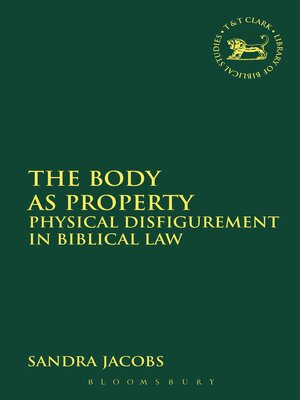The Body as Property
ebook ∣ Physical Disfigurement in Biblical Law · The Library of Hebrew Bible/Old Testament Studies
By Sandra Jacobs

Sign up to save your library
With an OverDrive account, you can save your favorite libraries for at-a-glance information about availability. Find out more about OverDrive accounts.
Find this title in Libby, the library reading app by OverDrive.



Search for a digital library with this title
Title found at these libraries:
| Library Name | Distance |
|---|---|
| Loading... |
The Body As Property indicates that physical disfigurement functioned in biblical law to verify legal property acquisition, when changes in the status of dependents were formalized. It is based on the reality the cuneiform script, in particular, was developed in Sumer and Mesopotamia for the purpose of record keeping: to provide legal proof of ownership where the inscription of a tablet evidenced the sale, or transfer, of property. Legitimate property acquisition was as important in biblical law, where physical disfigurements marked dependents, in a similar way that the veil or the head covering identified a wife or concubine in ancient Assyrian and Judean societies.
This is primarily substantiated in the accounts of prescriptive disfigurements: namely circumcision and the piercing of a slave's ear, both of which were required only when a son, or slave, was acquired permanently. It is further argued that legal entitlement was relevant also to the punitive disfigurements recorded in Exodus 21:22-24, and Deuteronomy 25:11-12, where the physical violation of women was of concern solely as an infringement of male property rights.
This is primarily substantiated in the accounts of prescriptive disfigurements: namely circumcision and the piercing of a slave's ear, both of which were required only when a son, or slave, was acquired permanently. It is further argued that legal entitlement was relevant also to the punitive disfigurements recorded in Exodus 21:22-24, and Deuteronomy 25:11-12, where the physical violation of women was of concern solely as an infringement of male property rights.







